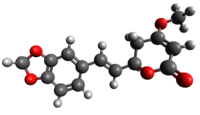
| |

| |
| Names | |
|---|---|
| Preferred IUPAC name
(6R)-6-[(E)-2-(2H-1,3-Benzodioxol-5-yl)ethen-1-yl]-4-methoxy-5,6-dihydro-2H-pyran-2-one | |
| Identifiers | |
3D model (JSmol)
|
|
| ChemSpider | |
| KEGG | |
PubChem CID
|
|
| UNII | |
CompTox Dashboard (EPA)
|
|
| |
| |
| Properties | |
| C15H14O5 | |
| Molar mass | 274.272 g·mol−1 |
Except where otherwise noted, data are given for materials in their standard state (at 25 °C [77 °F], 100 kPa).
| |
Methysticin is one of the six major kavalactones found in the kava plant.[1] Research suggests that methysticin and the related compound dihydromethysticin have CYP1A1 inducing effects which may be responsible for their toxicity.[2] Additionally, methysticin has been shown to potentiate GABAA receptor activity, contributing to the overall anxiolytic profile of the kava plant.[3]
Toxicity[edit]
Methysticin induces the function of the hepatic enzyme CYP1A1. This enzyme is involved in the toxification of benzo[a]pyrene into (+)-benzo[a]pyrene-7,8-dihydrodiol-9,10-epoxide, a highly carcinogenic substance. Another related compound is dihydromethysticin, which also induces the function of CYP1A1.[2][4][5] No report so far has described enhancement of CYP1A1 expression in animals or humans in vivo from any constituent of kava.[6]
References[edit]
- ^ Malani, Joji (2002-12-03). "Evaluation of the effects of Kava on the Liver" (PDF). Fiji School of Medicine. Archived from the original (PDF) on 2009-03-20. Retrieved 2009-09-04.
- ^ a b Li Y, Mei H, Wu Q, Zhang S, Fang JL, Shi L, Guo L (Dec 2011). "Methysticin and 7,8-dihydromethysticin are two major kavalactones in kava extract to induce CYP1A1". Toxicological Sciences. 124 (2): 388–99. doi:10.1093/toxsci/kfr235. PMC 5736320. PMID 21908763.
- ^ Boonen, G.; Häberlein, H. (1998). "Influence of genuine kavapyrone enantiomers on the GABA-A binding site". Planta Medica. 64 (6): 504–506. doi:10.1055/s-2006-957502. PMID 9776662. S2CID 45511040.
- ^ Beresford, AP (1993). "CYP1A1: friend or foe?". Drug Metab Rev. 25 (4): 503–17. doi:10.3109/03602539308993984. PMID 8313840.
- ^ Uno, S; Dalton TP; Durkenne S; Curran CP (2004). "Oral exposure to benzo[a]pyrene in the mouse: detoxication by inducible cytochrome P450 is more important than metabolic activation". Molecular Pharmacology. 65 (5): 1225–37. doi:10.1124/mol.65.5.1225. PMID 15102951. S2CID 24627183.
- ^ Yamazaki, Yuko; Hashida, Hiroko; Arita, Anna; Hamaguchi, Keiko; Shimura, Fumio (2008). "High dose of commercial products of kava (Piper methysticum) markedly enhanced hepatic cytochrome P450 1A1 mRNA expression with liver enlargement in rats". Food and Chemical Toxicology. 46 (12): 3732–3738. doi:10.1016/j.fct.2008.09.052. ISSN 0278-6915. PMID 18930106.
Well, that’s interesting to know that Psilotum nudum are known as whisk ferns. Psilotum nudum is the commoner species of the two. While the P. flaccidum is a rare species and is found in the tropical islands. Both the species are usually epiphytic in habit and grow upon tree ferns. These species may also be terrestrial and grow in humus or in the crevices of the rocks.
View the detailed Guide of Psilotum nudum: Detailed Study Of Psilotum Nudum (Whisk Fern), Classification, Anatomy, Reproduction